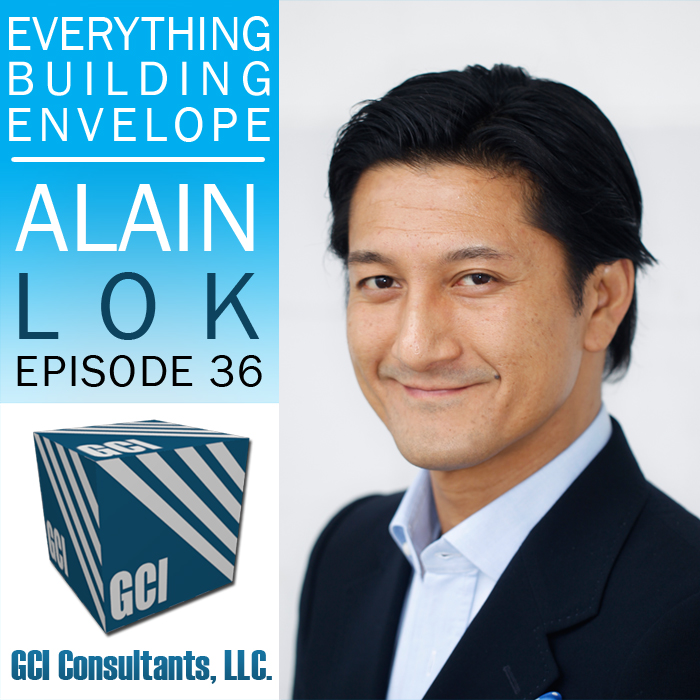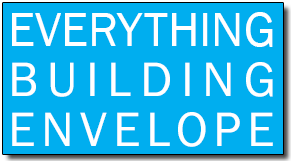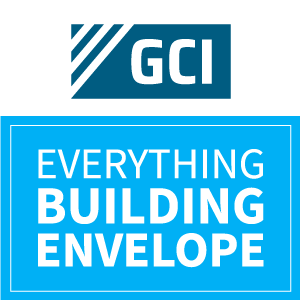
About The Everything Building Envelope Podcast: Everything Building Envelope℠ is a dedicated podcast and video forum for understanding the building envelope. Our podcast series discusses current trends and issues that contractors, developers and building owners have to deal with related to pre and post construction. Our series touches on various topics related to water infiltration, litigation and construction methods related to the building envelope.
https://www.everythingbuildingenvelope.com
*** Subscribe to the show and leave us a Review on ITunes!
Paul: Hello everyone. Welcome to the “Everything Building Envelope” podcast. Our guest today is Alain Lok with Kryton International. And they make an admixture for waterproofing concrete. So, welcome, Alain.
Alain: Thank you very much. Thank you for having me, Paul.
Paul: My pleasure. So, excited to hear about concrete waterproofing. So could you maybe tell us a little bit about yourself and also Kryton?
Alain: Yes, I’d be happy to. My name is Alain Lok, I’m the senior business manager for the eastern U.S. So I cover the eastern portion of the country from Maine all the way down to Florida. And I manage our… and support our distribution network and I conduct a lot of presentations and similar things like this podcast.
Paul: So, tell us a little bit about Kryton.
Alain: Well, Kryton specializes in building dry and durable concrete structures using smart concrete technology. One of which is a crystalline waterproofing called Krystol technology. And since ’73… Oh, you know, we are now a 44-year-old company, still family owned. We are in over 50 countries with over 100 distributors worldwide. And we hail out of Vancouver, British Columbia, Canada.
Paul: Wow. So, and you have a crystalline material or product. Would you call it a product or a material?
Alain: It’s a material.
Paul: So you have a crystalline material and you call it Krystol, K-R-Y-S-T-O-L, technology. So, can you tell us what that is and how it works?
Alain: Sure. Well, Krystol technology…it’s a trademark term to describe the crystalline technology. And, you know, it goes in with the products that we have. So it’s added directly to the concrete mix or applied to the surface of concrete. And once added, the crystal chemically reacts with water and unhydrated cement particles to form insoluble, needle-shaped crystals.
And these crystals fill capillary pores and micro cracks in the concrete to block pathways for water and waterborne contaminants. As well, the crystal will continue to give the concrete structure a self-sealing ability. So, if water is reintroduced through a rise in hydrostatic pressure or through hairline crack or through voids in concrete, the crystals will initiate further crystallization to ensure, you know, essentially permanent waterproof protection. And this happens for the life of the concrete.
Paul: That’s interesting. So you said that it can be an admixture or it can be surface-applied?
Alain: Yes. One of the easiest ways, if you like, to apply or add the products to the concrete is by an admixture. And that admixture is called Krystol Internal Membrane or KIM Admixture, as it’s known in the market.
Paul: So, what are the applications for it, I mean, obviously, I mean, so what kind of uses would it be for? It sounds like it will be slab on grade. Would it be below grade, what other or anything else?
Alain: Right. Well, the Krystol technology and, you know, that includes the KIM admixture. You know, it can be used in really all types of concrete structures, whether it’s below grade, above grade, such as the below-grade parking, basement, sewage, at treatment plant, water containment structures of all types such as swimming pools, foundations. We also do a lot of dams, you know, tunnels and infrastructure projects. So, anything concrete, you can actually use the crystal technology to waterproof it.
Paul: So, if you’re using it as an admixture, do you recommend also surface applying it or is that more of a remedial application?
Alain: Yeah, that would be more of a remedial. Now, if you were to use the KIM admixture, you can use that as the sole and primary waterproofing system. So, I mean, yes, you can use it along with a traditional membrane system or use it as the sole waterproofing system on its own.
Paul: So, what are the main advantages of the Krystol technology over, say, a membrane or a coding system?
Alain: Sure. Well, the typical benefits of the crystal technology over traditional membrane systems are, you know, they provide a more of a permanent and reliable water-proofing solution. It helps to greatly shorten the construction schedule by reducing and eliminating the need to apply the membrane system. It also helps to reduce initial and long-term waterproofing cost by greatly reducing or, you know, reducing the risk for callback at future leaks and remediation work. And, as well, the self-sealing ability does also help to prevent, you know, future repairs and other types of issues that you may get with, you know, deteriorated or leaky membrane systems.
Paul: I know with below grade in particular, and maybe on grade and other applications that, a lot of users like to get a warranty with that. Is there a warranty issued here? Is there different options or how does that work?
Alain: Yes. Now, the KIM admixture does provide a 25-year limited product warranty. And that’s essentially, you know, tops and unmatched with, you know, in the industry for crystalline waterproofing product. So that is a warranty that guarantees that the product is, you know, free of defects and doesn’t perform as stated, we, Kryton, we’ll provide free repair materials for the duration of the 25-year period.
We also offer a 10-year labor and material warranty, and we call it the Krystol Assurance Program or KAP. And what that entails is very common, you know, with other systems that you… if there’s any issues, both labor and material is provided to remediate any leaks and damp spots within the structure.
Paul: So, I’m sure it doesn’t happen very often, but if you do have to go in and do remediation, how does that work? Do you have to dig out or is there a way to do it from the inside working out?
Alain: Yeah. So, you know, on the chance that you have to, you know, repair concrete or do remediation, we do have a line of products that can be applied either on the positive or the negative side. And it’s actually different from, you know, other repair systems like injection or, you know, grout injection where you use PDU or epoxy. We have a system that’s called the leak repair system. And that utilizes a hydraulic plug, a crystalline grout and a surface treatment. And those three work together.
Paul: I don’t know what a hydraulic plug is.
Alain: Oh, so the hydraulic plug is like a… it’s a very fast-drying cement.
Paul: Can you describe what is KIM admixture and how it works?
Alain: Sure. Now, KIM admixture is a hydrophilic crystalline admixture used to create permanently waterproof concrete. Now, KIM lowers the permeability of concrete and is used in place of externally-applied waterproofing membranes. So by stopping the transmission of water through concrete, KIM adds durability and longevity to concrete by protecting it against chemical attack and erosion of reinforcing steel.
Now, the KIM admixture contains the Krystol technology and it’s added to concrete at the ready mix batching plant. And it’s simply added together with the other ingredient and it’s mixed and then you would simply, you know, go on site and then pour the concrete, consolidate, vibrate, finish and cure as per normal ACI concreting guidelines, nothing more and nothing less.
And how it works is, it will now turn the concrete into the waterproofing barrier. So, compared to a membrane system where you’re simply, what you’re doing is you’re applying a barrier between the water or the water table and the concrete, and relying on a thin layer of protection. You’re now, with the KIM admixture, turning the concrete into the waterproofing barrier. So if you have, let’s say, if you have an eight-inch wall, you now have eight inches of protection. If you have a two-foot slab, you now have two feet of waterproofing protection versus relying on a sheet membrane.
Paul: You were saying that if concrete, you know, if it develops cracks that the admixture would self-heal so to speak, I don’t know if that’s the right terminology for it.
Alain: Yes. So there is the…one of the main features of the crystal technology and in turn, you know, with the KIM admixture is the self-sealing. And what that is, it’s an autogenous feature where once water comes in contact with the crystals, the crystals will reactivate and seal up any hairline cracks up to 0.5 millimeters in width. As well, if you have any damp spots, you know, dampness which is quite common, those damp spots will simply dry up on their own through the self-healing feature. It’s really a great way to avoid having to go in and, you know, fix every single leaking crack and damp spot that you would get in concrete.
Paul: Where has this been used?
Alain: Well, the KIM admixture… I didn’t mention earlier but, you know, we, Kryton actually invented the crystalline admixture back in 1980. And since then, it’s been used all over the world, you know, waterproofing many deep hole foundations, you know, tunnels, dams, and other types of major infrastructure projects. And especially in the East Coast, we have hundreds of projects, you know, from Boston down to New York City to the D.C. metro area, and then down into Florida. So again, it’s been used in multiple applications for well over three decades.
Paul: How does it work in areas like Florida where the water table is very close to the surface?
Alain: Well, the KIM admixture is actually very effective in places like Florida where you, you know, you dig down a few feet and hit the water table, or there’s a very high water table. Really, that’s really the, you know, the strength, the robustness of the KIM admixture is that it is used in place of membrane system to provide that reliable waterproofing protection, whether you have a few feet, whether you are a few feet in the water table or you’re, you know, you’re dozens of feet into the water table.
And we have many examples where we have situations where it’s very high hydrostatic pressure, very high water table, many feet below sea where, you know, the product has shown to be very, very reliable, and essentially keep the water out of the structure.
Paul: Are there any restrictions with saltwater intrusion?
Alain: No. It actually performs very well in salt water, as well when there are, you know, as you know, with water is a carrier of many aggressive chemicals. You know, whether we’re looking at chlorides or sulfate, the water….the crystal technology, you know, keeps the water at bay and it’s actually able to resist hydrostatic pressure up to 460 feet, backed up with third-party testing.
Paul: Yes. Seems like since it’s part of the concrete that it would… that would be a strength of the system.
Alain: Yeah, yeah, and, you know, in addition, because you mentioned, you know, salt water, the KIM admixture, it has been tested in tidal condition where there’s salt water and it does show to be highly effective at preventing corrosion. There’s actually a solicited study, 10 years, through the University of Hawaii, where they tested various corrosion inhibitors along with our admixture and [inaudible 00:13:32] products. And, you know, in a nutshell, they did conclude that the addition of the KIM admixture was very effective at preventing corrosion. And again, this is a 10-year study that was unsolicited.
Paul: Has it been used in the high rise buildings in coastal areas for the problem with rebar corrosion and concrete spalling?
Alain: Yes, yes. Yes, it definitely has, and again we have hundreds of examples, you know, not just in the U.S. but in North America and globally. And again, you know, with the ability for it to resist high hydrostatic pressure and in turn, preventing chemicals and salt water from getting into the concrete, it’s really a great way to prevent corrosion in, you know, high rise foundation. And as well, the ability of the KIM to produce simply higher quality tighter concrete, you know, your risk of spalling and honeycombing is reduced. Of course, you know, spalling and honeycombing is also relied upon, you know, good concrete practices like proper finishing and curing.
Paul: Yeah, makes sense. So, how’s the KIM admixture different from other crystalline admixtures?
Alain: Yes that’s a great question. Now, I think the first thing to note is that not all crystalline technology, not all crystalline products are the same. You know, the first factor to really be aware of is that the crystalline technologies are chemically different. For example, our Krystol technology is based on a reaction with water and unhydrated cement. And we’re actually very unique in the industry, in that we’re the only company with the crystalline technology that reacts with water and unhydrated cement. Whereas, there will be other systems where it’s available, you know, right on their technical data sheet that their crystals form through a reaction with free lime and concrete, you know, free lime being a byproduct of hydration.
So what you’re getting is, you’re getting different types of crystals. You know, essentially, physically, they’re very different. Ours is very long and needle-like. And they’re purely hydrophilic, so they use water, they like water to grow and to reactivate, in turn growing more crystals. And that really, you know, lends to the self-healing feature of the crystal technology. So, chemically, there is a difference. And then second, the chemical difference leads to a difference in performance. Anyway, we’re… you know, I guess we will get into, you know, what’s better, what’s worse, but, you know, do look at the different performance values of individual products.
Paul: Seems like, you know, being compatible with moisture as opposed to most things are incompatible with it would be a big plus for the KIM admixture.
Alain: Yeah, yeah. I mean, it’s a good point, you know, because some other materials would be, you know, densifier or hydrophobic pore blockers, those are better used in, you know, above grade conditions or where there’s very little hydrostatic pressure because those… like, for example, hydrophobic materials, those, they would plug up the capillaries in the concrete but, you know, when you get very high hydrostatic pressure, the water just passes through… eventually, pass through those materials. With crystalline being…you know, with Krystol technology being hydrophilic, if water tries to get through, it actually uses up that water to fill up any available voids in the concrete.
Paul: Interesting.
Alain: And once the crystals are formed in the concrete, it really, it’s permanent and it becomes part of the concrete matrix. So it doesn’t deteriorate over time. And we always say, “If the concrete is sound and standing, the crystals will remain in the concrete, protecting the concrete.”
Paul: What other types of products do you offer?
Alain: Yes. So, in addition to the KIM admixture, which is used only for new concrete, new construction, we do have, you know, a very comprehensive product line where you can…where there’s a topical product called Krystol T1, T2. So it’s a surface treatment that is applied to both new or existing concrete. And there’s also a repair system called Leak Repair System, where it’s used to remediate leaks, and cracks, and damp spots, and leaking joints in concrete. And we also have a system for jointing, for construction joints, preplanned and unintended cold joints as well as crack control joints. In addition, we have products for pipe penetration and tie hole and as well a sealer called Hydropel. So, you know, there’s a very comprehensive system that will allow you to not just tank a structure but to go in afterwards if there’s an issue to remediate and rehabilitate.
Paul: So basically, you have everything you need concrete, related to concrete and ceiling?
Alain: That’s correct. That’s correct.
Paul: So, do you have a final message for the waterproofing and construction industry?
Alain: Well, the final message is, you know, there’s lots of options on the market. You know, with a lot of designers, you know, whether you’re an architect or an engineer, there are options available. But that’s…and at the same time, with the crystal technology, you know, it’s something that’s been around now for well over four decades. A proven technology that’s been used in all types of challenging conditions, you know, not just in Florida, but throughout the U.S. and globally.
But to really consider, you know, the overall pros and cons of, you know, whatever type of system that you are looking to specify and introduce to the end user, to the owner/developer. So, you know, if you’re… if people are looking for, you know, a quicker, easier more permanent method to waterproof concrete, you know, consider the use of crystalline waterproofing. You know, it’s something that you cannot…you may necessarily not be able to be to see and feel as you get with a traditional membrane system. But it’s actually, it’s something that is highly beneficial to the concrete and will add, you know, many years to the durability and service life of the structures that we are all a part of building.
Paul: Did I hear you say before also that there are cost advantages to using the product?
Alain: Yes. So, you know, with the use of the KIM admixture over your traditional membrane system, the cost advantage is, number one, you are able to eliminate, you know, the need to apply the product, you know, the labor required. So, you know, the cost of the KIM admixture, you’re simply just paying for the material. There’s no added cost for labor. It also helps to save and shave the construction period. So if you can imagine, there’s no need for surface prep and obviously, you know, you don’t need to apply the product. And that really can, if you’re dealing with a large foundation, can shave days if not weeks off the construction schedule. And that all, you know, can all translate into money saved for everyone.
Paul: So, if people wanna find out more about Kryton and the products offerings, how would they go about doing that?
Alain: Well, we have a really great support structure. You can definitely contact the headquarters at www.kryton.com. We also have a toll-free number. As well, we have a…in Florida, we have an exclusive distributor, and they’re called ABC Supply and they’re more than happy to assist with inquiry and provide sales and technical support.
Paul: So Alain, really good information, appreciate you sharing it with the listeners. And thank you very much for taking the time to come on “Everything Building Envelope” podcast today.
Alain: You’re very welcome. And I’d like to thank you for taking the time, Paul. And we’re very grateful to be part of your podcast here. You know, hopefully, there’s an opportunity to work with you and your customers in the near future.
Paul: Yeah. So, thanks again. So, this concludes another episode of the “Everything Building Envelope” podcast. Please, tell your friends and colleagues about it. And you can access it through our website, www.everythingbuildingenvelope.com or through iTunes or Android sources as well such as stitcher.com. So, until next time, this is Paul Beers saying, so long.


